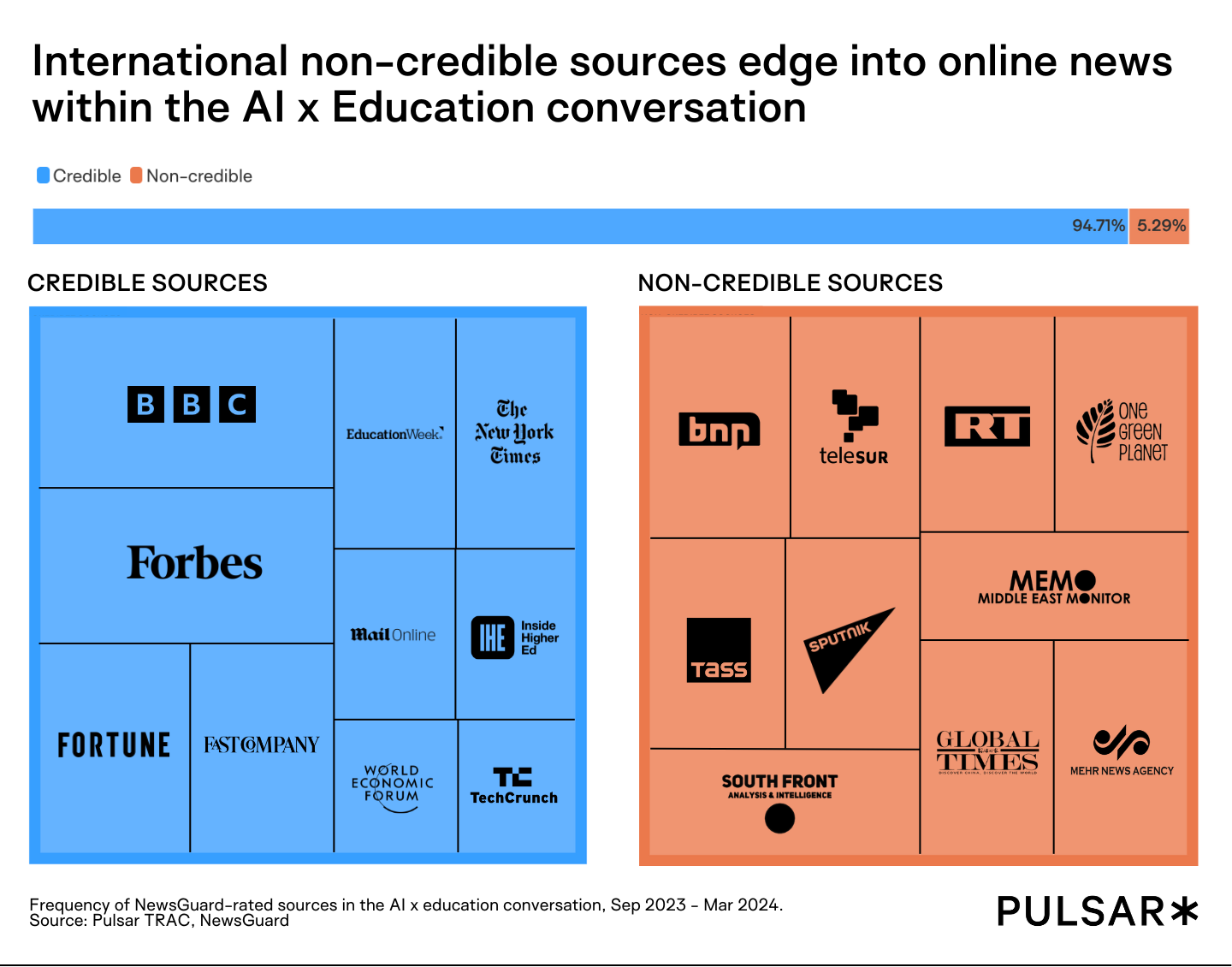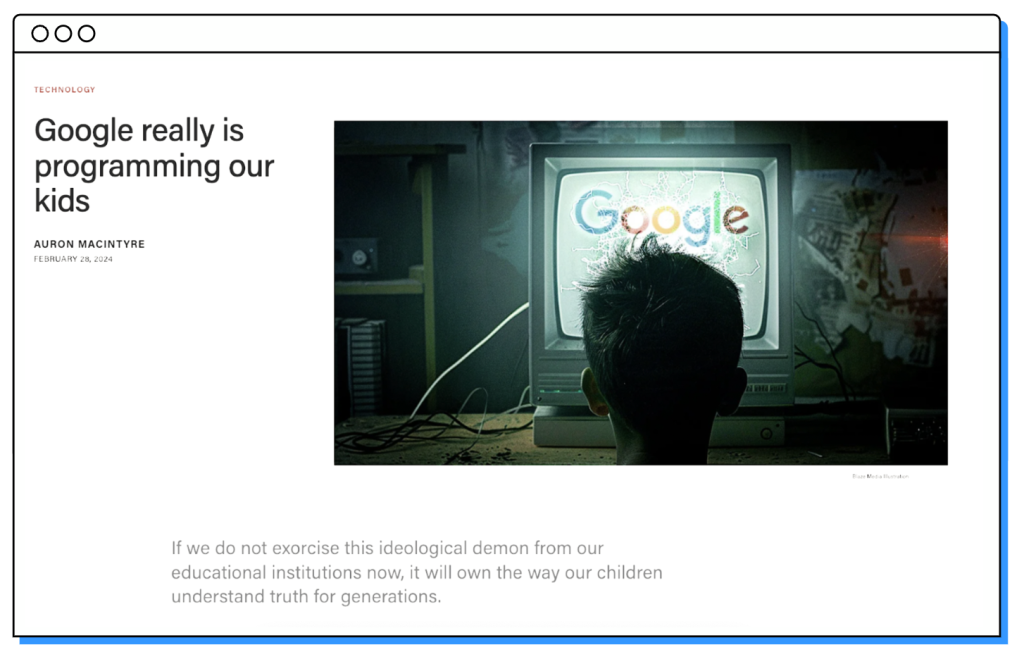
How AI is impacting education – mapping the audience response to a technological breakthrough
- Education
Following the advent of publicly available AI tools that can write essays at the drop of a hat, AI is making its way into the education conversation more and more.
From teachers including secret AI-busting instructions in homework assignments to classes working alongside AI to prepare the workers of tomorrow for AI-integrated jobs, the use of large-language modeling in education is sparking large amounts of conversation online.
The Office of Superintendent of Public Instruction (OSPI), the body in charge of K-12 education for Washington state, has partnered with Pulsar to delve into this conversation and what audiences are saying about AI in conjunction with education. OSPI tells us that “with the tech industry rapidly building AI applications, students and teachers were bringing these tools into the classroom” they wanted a way to “measure how the public was reacting to this emerging paradigm.”
In June 2024, OSPI issued updates to its human-centered guidance for educators on the use of AI in K-12 public education. The team aim to address educators’ concerns by tracking and analyzing the impact of AI on students and schools. For example, educators and parents are increasingly concerned about students cheating, though Stanford research that shows the prevalence of easy-access large language models such as ChatGPT hasn’t increased the amount of cheating among high-school students.
OSPI’s train-the-trainer sessions aim to educate teachers and staff in many AI tools in order to improve AI literacy in schools to work with emerging tools rather than fight against them. OSPI has already found that AI tools can be used to improve access to reading and language adoption among children, removing barriers and improving inclusion in reading education.
Can A.I. tutor kids in reading?
As Louisiana seeks to 'vastly expand' intensive tutoring, it's trying out a reading program powered by artificial intelligence. The program listens to kids read aloud and shows them how to sound out words that stump them.https://t.co/IdX71iAh6d
— Patrick Wall (@patrick_wall) March 5, 2024
When we look at the wider conversation around AI in education (excluding university & college) and examine the narratives, we see a level of polarization in the subject. The conversation is nuanced, with reactions from backlash, abject support and careful caution from educators, parents, politicians and internet pundits.
Governments must quickly regulate #GenerativeAI in schools. This technology can be an opportunity for human development, but it can also cause harm & prejudice. It cannot be integrated into #education without the necessary safeguards.#DigitalLearningWeek https://t.co/agX5pTI9gT
— Audrey Azoulay (@AAzoulay) September 7, 2023
In the AI x education conversation, OpenAI’s ChatGPT is the biggest AI tool mentioned by far. This is unsurprising considering its role as a poster child for AI tools everywhere, with people often using ‘GPT’ when referring to LLMs in general. We see image generation tool Midjourney being the second-biggest AI tool, largely stemming from news articles and blogs that cite the tool as one that’s dampening creativity.
However, when we expand our vision to look at all AI tools mentioned, and group them by type, we see another narrative take shape.
Though text-based and image generation tools are dominating, tools made specifically for educators such as Canva Magic Classroom and Khanmigo are making a modest but significant contribution to the conversation. Here in the tools made specifically for education, there isn’t any one break-out tool in the group.
I think the future of education is AI. However, the education system is extremely linear, and reforming education for our kids will be a big challenge to overcome in the next decade.
Khanmigo is an example of how AI can help democratize education. Can you think of any others? pic.twitter.com/7CNNusViN4
— Peter H. Diamandis, MD (@PeterDiamandis) January 9, 2024
We see this conversation permeate globally too, with a great presence on Russian social network VKontakte, as well as French educators on X. Edtech connoisseurs and educators are unsurprisingly playing a large part in the AI x education conversation.
We examined who’s joining the conversation on X.
Here we visualize the sub-audiences and their interconnectivity. This shows distinct groups and how they behave online with each when talking about education and AI. The lines represent interconnections between the different members of the segments. The bigger the node is, the more connected it is to the rest of the members in the audience.
With EdTech Leaders and Education Researchers, we see a nuanced discussion of the impact of AI on education as a whole, who show concern for unfettered and unregulated AI technology advancements in the field.
I had the privledge of attending the education symposium at AAAI. While I enjoyed the discussion and am grateful for the people I met, my overwhelming impression was that AI in education is being advanced without educators and by people with little background in K12 education 1/
— Willie Agnew | wagnew@dair-community.social (@willie_agnew) March 5, 2024
Tech Innovators on the other hand tend to show a passion - rather than hesitance - for bringing AI into education, with the conversational nuance being technical details about how AI is integrated, including conversation around mathematical AI training and
AI gives every student a 1-on-1 tutor.
I hooked up GPT-4 Vision & OpenAI Whisper/TTS to a camera for a 5min prototype.
Showed it a math problem, and it explained it.
Imagine giving a better version of this to *every* student in the world.
The future of education is so bright. pic.twitter.com/WqqZxQAKaU
— Mckay Wrigley (@mckaywrigley) February 27, 2024
The uses of AI in education are clearly so far reaching that they’re sparking a plethora of reactions from communities. We examined the school subjects most attached to the conversation surrounding AI in education.
Within each subject conversation, we find narratives about how AI in education will affect students’ future job prospects. This is especially present in conversations around vocational education with calls for AI-specific vocational training to be given in areas such as robotics, engineering and electronics.
Enhance the repositioning of the education system towards STEM, robotics, AI, and vocational skills to cope with the demands of the 4th Industrial Revolution and job creation will go a long way to empower the youth will drastically reduce unemployment#BOLDSolutionsForTheFuture
— NATIONAL TESCON SECRETARIAT (@national_tescon) March 24, 2024
Also present is a focus on social studies stemming from narratives such as AI image generation’s role in Art History education, with algorithms being trained to find patterns and learning moments for students from famous artworks. The art-based focus also spreads to the visual and performing arts, where conversation is dominated by the AI technologies that allow image, video and deepfake actors to be made via prompts.
When we look at which school subjects sub-audiences are talking about, we can see certain communities gravitating towards certain areas. It’s no surprise that Progressive Artists have a strong focus on the visual & performing arts - almost to the exclusion of all other subjects. Here the conversation largely follows the creation of art learning materials that are themselves made by AI, as well as the impact of AI art and music generation on learning the fundamentals of the art and music theory itself.
I said many times I fear for the next generation of artists. And here we are, not only has AI invaded the schools, but now they're selling "how to draw" books for folks who are not receiving a formal art education. I learned how to draw from books, so this hits hard. https://t.co/wXhB300b7V
— Glynn Tarrant 🏳️🌈🇺🇲🎨 (@GlynnTarrant) November 12, 2023
EdTech Leaders care deeply about AI-enabled mathematics tools, whilst Religious Conservatives heavily discuss vocational education. This stems from conversations about news items from countries such as China and Zimbabwe where AI is being introduced to train vocationally for students in areas such as food preparation and robotics - as well as Indian AI-enabled tablets being sold to US schools.
As we can see, Tech Innovators and Education Researchers have a more general approach to the AI x education conversation, making larger, zoomed-out statements:
AI is to humanities what the calculator was the mathematics.
Getting rid of the calculator wasn't the solution.
I have 6+ years of experience in tech and education. This is what schools *should* do to address AI👇
— Vivian Shen (@vivianmshen) September 13, 2023
As the education sector and population increasingly embrace AI and edtech, the way AI is viewed in education is changing. As preventing cheating through ChatGPT will prove as difficult as stopping kids using a calculator for math homework, students and teachers using AI may become integrated as taboos dissolve and perspectives shift.
Is AI or @chatGPT cheating? Talking about how to use AI in education and the new debate! #FETC #vbits @StephLawrence12 @DrManigo @ladavids_a pic.twitter.com/XCr8eCv8vI
— MrsHoldcraft (@MrsHoldcraft) January 24, 2023
However, one needs to know mathematics to use a calculator correctly, but one doesn’t need to know literary structure to get ChatGPT to write a novella. These kinds of conversations among audiences spark wonder of whether AI will provoke a change in the standards of academic integrity.
Now to get meta: there’s one more spanner in the works that has the chance to threaten the integrity of the conversation about education’s integrity. The prevalence of non-credible sources in the AI x education is high at over 5%. These non-credible sources are noted by reliability rating platform and Pulsar partner NewsGuard for being of high risk of spreading misinformation.

Five percent may seem low, but even at much lower rates of non-credible sources, one drop of misinformation has the ability to affect a whole conversation - in this case, meaning educators and parents will struggle to make well-informed decisions about their child’s education.
Misinformation narratives in the AI x education conversation include UK schools installing AI-driven cameras in pupil bathrooms, Chinese AI bases in schools and claims that Google’s AI Gemini is anti-capitalist, pro-liberal and a threat because it’s being used by educators. There’s also a prevalence of non-credible sources meticulously documenting times when schools make AI-based decisions.

For these reasons it’s extremely important that those making decisions in education listen to the online conversation around AI - OSPI tells us that they “believe in empowering educators with the tools to improve student learning outcomes and reduce their work hours spent on ancillary tasks. AI is promising with equal measures of concern and possibility.”


